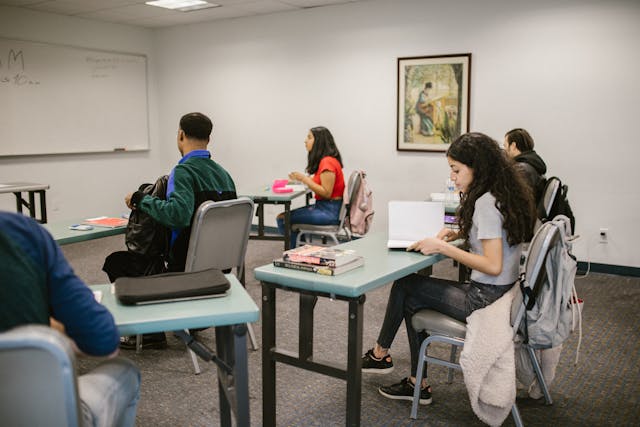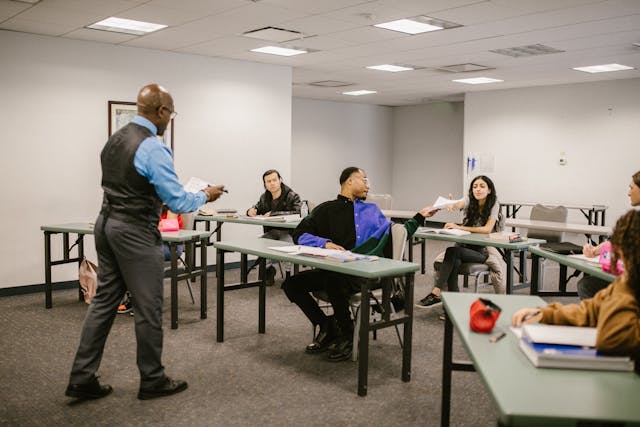Promoting equity in education

Educational equity ensures that every student has meaningful access to the resources, support, and opportunities that fuel success. Yet persistent achievement gaps and uneven access to services raise important questions: How do we meet the needs of all learners? And what does true equity require from schools today?
What is educational equity?
While the terms are often used interchangeably, educational equality and equity are distinct concepts; understanding their differences is crucial.
Equality in the classroom means all students have access to the same resources, regardless of their background or starting point. Equity in the classroom means tailored support is available for all students based on individual needs.
When it comes to educational equity, one size does not fit all. One lesson plan or resource cannot meet the needs of every student. Providing resources like additional learning materials, language support, and mental health services can have a significant impact on a student’s ability to learn. Unfortunately, numerous systemic factors contribute to the inequities in education.
Some common factors that impact a child’s ability to succeed include:
- Funding issues
- Bias
- Lack of access to technology
- Housing instability
- Financial insecurity
- Lack of diversity
- Ineffective teacher-to-student ratios
- No cultural representation
Promoting equality and diversity in schools is an ongoing process. A one-off solution or effort won’t be enough. It takes a collaborative effort, along with structural, instructional, and cultural shifts, to bring about real and effective change. That said, when it’s done well, it can change a student’s life and future.
Why promoting equity in education matters
Educational equity improves academic outcomes, engagement, and long-term success. Studies show that inequities can hinder student achievement, and research highlights the glaring differences in test scores between lower-income districts and wealthier ones.
Intentional interventions and support programs—such as inclusive classrooms and teaching practices, and targeted scholarships—can help narrow these gaps. When students feel seen and supported, they’re more motivated and successful. They’re more likely to participate, feel a sense of belonging, and have the confidence they need to pursue their goals.
“Students who perceive that they have lower levels of control because of the limited resources around them can experience lower levels of motivation and symptoms of anxiety and depression. They may feel that they are on a trajectory that they do not have control to change course.”
- Laura Magnuson, MA, MS, LAMFT, VP of Clinical Engagement
Key strategies for promoting equity in education
Achieving equity in education can feel like a daunting task, but having a roadmap with proven, effective strategies makes your path much easier. The following classroom equity examples can transform your school culture, ensuring that all students have the opportunity to succeed.
Overcoming systemic barriers
To create sustainable change that lasts, you should first examine the policies and funding structures that might be contributing to equity concerns within your school.
Recent studies suggest that students from higher socio-economic backgrounds tend to perform better in school, are more likely to graduate, and can secure jobs more easily later in life. Educational equity starts with allocating resources to the students who need them most.
To do this, we must first identify the most disadvantaged population. Making efforts like increasing per-student funding, reducing class sizes, and ensuring students have access to up-to-date technology can help your school overcome some of the most common barriers.
Systemic barriers that impact students include:
- Disparities tied to local property taxes
- Bias in disciplinary practices
- Limited technology, supplies, and internet resources
- Unequal access to advanced coursework
- Lack of extracurricular programs
- Inexperienced teachers and counselors
- Racial and economic segregation
- Policies contributing to the school-to-prison pipeline
Tailoring support and addressing individual needs
Meeting students on their terms to address their individual needs is pivotal for creating equity in classrooms and schools. Schools that excel in educational equity recognize the importance of allocating dedicated resources, implementing targeted interventions, and offering programs that address both academic and social-emotional needs.
For example, for students from lower socio-economic backgrounds, this might mean offering support through free meals, reduced or waived transportation costs, and access to tutoring. Multilingual Learners (MLLs) could benefit from additional instructional support and easy access to bilingual materials.
Ways to tailor support and promote equity in schools:
- Implement reading interventions
- Use small group support
- Adjust timelines for students who need it
- Improve access to mental healthcare services
- Offer flexible scheduling
- Use trauma-informed teaching practices
- Create mentorship or peer-support networks
- Adopt social emotional learning (SEL) curricula
- Invest in assistive technology and specialized learning tools
- Establish multilingual environments that incorporate home languages in instruction and communication
Inclusive curriculum and representation
There’s incredible power in students seeing themselves in what they learn. Prioritizing representation in curriculum is an integral part of equitable education.
Showcasing diverse authors, histories, and role models means every student, regardless of background or economic situation, feels validated and seen. According to studies, culturally relevant curriculum promotes strong engagement and school attachment, and can even improve academic outcomes.
“Students respond to material that they can relate to and so if they see representation in the materials they are more likely to engage and have higher levels of well being.”
- Laura Magnuson, MA, MS, LAMFT, VP of Clinical Engagement
Culturally responsive teaching practices
When teachers are trained in culturally responsive methods, they can help students develop strong identities and feel a sense of connection to what they’re learning. This is more than celebrating heritage months. It’s about creating space for dialogue and adapting lessons to fit a cultural context that resonates with students. This practice can offer students a strong sense of student belonging and provide supportive environments where they’re more likely to find success.
Equitable access to resources
Equitable access to educational resources means that every classroom has the necessary supplies, tools, resources, and technology that students may need. It ensures that students have internet access at home and that extracurricular opportunities are available to everyone.
There are demonstrated benefits to offering accelerated programs and challenging coursework. When students are encouraged to grow academically, it can close the gap that might otherwise stifle their learning process.
Professional development for resources
Teachers, staff, and administrators need professional and educational development that’s centered on equity in the classroom. Schools should invest in ongoing training that focuses on equity, diversity, and inclusion (DEI) to prepare teachers to implement an inclusive curriculum in the classroom. Training can also help them understand positive, effective ways to respond to trauma and reduce bias.
Ideas for professional development topics:
- Recognizing and reducing implicit bias
- Culturally responsive teaching
- Trauma-informed care
- Equitable assessment and grading policies
- Inclusive lesson plans and materials
- How to engage with diverse families and communities
- Leadership development focused on equity-centered policy
- Collaborative learning communities that allow educators to share best practices
- Coaching and mentoring programs
- Certification programs focused on DEI strategies
Family and community engagement
Promoting equality and diversity in schools can’t happen in a silo. Creating partnerships with families and communities can significantly widen your reach. Research indicates that family engagement is a significant predictor of positive student outcomes at all levels of education.
Ways to promote family and community engagement:
- Post community forums
- Increase language accessibility
- Invite parents to school planning sessions
- Create parental advisory boards
- Host cultural workshops and learning sessions
- Develop and promote digital platforms that enhance family communication
- Use community liaisons to bridge the gap between schools and diverse family dynamics
Challenges and opportunities ahead
All of the ideas presented here are designed to enhance equity in education, but change is rarely possible without some obstacles. From budget constraints to staff shortages and community pushback, you may encounter resistance as you address inequity in your school. Embedded systemic inequality can be difficult to overcome, especially when the political climate threatens funding.
Despite the challenges that might lie ahead, the positive outcomes far outweigh any negatives. New technology can close the gaps, innovative policies can reallocate resources, and data transparency makes it easier than ever to track progress, identify at-risk students, and advocate for ongoing change.
Building a more equitable future for every student
Implementing equity in education can benefit students from all backgrounds. It creates dynamic learning environments and fosters a culture where students learn to contribute and are well-equipped to thrive academically. Diverse classrooms teach students leadership, empathy, and other essential skills critical to their futures.
Implementing equitable strategies such as tailored support, professional development, equitable funding, an inclusive curriculum, and strong family engagement will all make a difference. As educators, you’re at the center of a movement that understands the importance of equity in education. By committing to it, you’re improving the lives of all students. You’re helping them feel valued and supported and teaching them that they’re capable of reaching every goal in life.
Talkspace can be your ally in creating equitable learning environments where all students have access to the resources they need, including therapy for students. Request a demo today to learn more about how Talkspace is helping promote equality and diversity in schools.
Sources:
- Naim, Arshi. 2025. “Equity Across the Educational Spectrum: Innovations in Educational Access Crosswise All Levels.” Frontiers in Education 9 (January). https://doi.org/10.3389/feduc.2024.1499642. Accessed November 6, 2025.
- Cabral-Gouveia, Carmo, Isabel Menezes, and Tiago Neves. 2023. “Educational Strategies to Reduce the Achievement Gap: A Systematic Review.” Frontiers in Education 8 (May). https://doi.org/10.3389/feduc.2023.1155741. Accessed November 6, 2025.
- Johnson, Angela, and Samantha Elliott. 2020. “Culturally Relevant Pedagogy: A Model to Guide Cultural Transformation in STEM Departments.” Journal of Microbiology and Biology Education 21 (1). https://doi.org/10.1128/jmbe.v21i1.2097. Accessed November 6, 2025.
- Villalobos, Karen. 2025. “Family Engagement Matters for Student Success.” EdCal. July 3, 2025. For educators, administrators, and policy leaders, this work is urgent and fundamental. The decisions you make now have a lifelong impact on every student in your school. This guide walks you through what equity in education truly means and how to start driving it in a tangible and meaningful way.. Accessed November 6, 2025.






